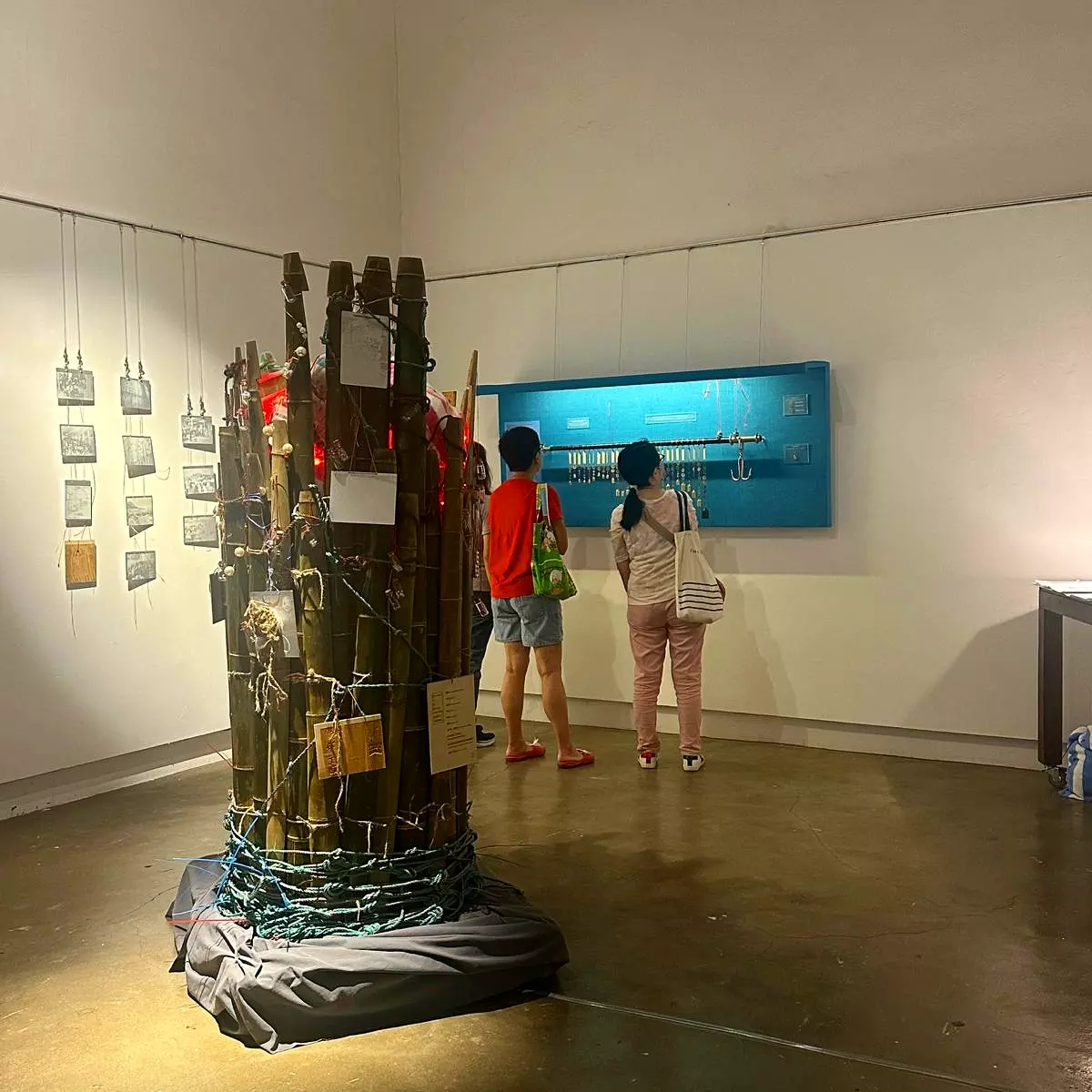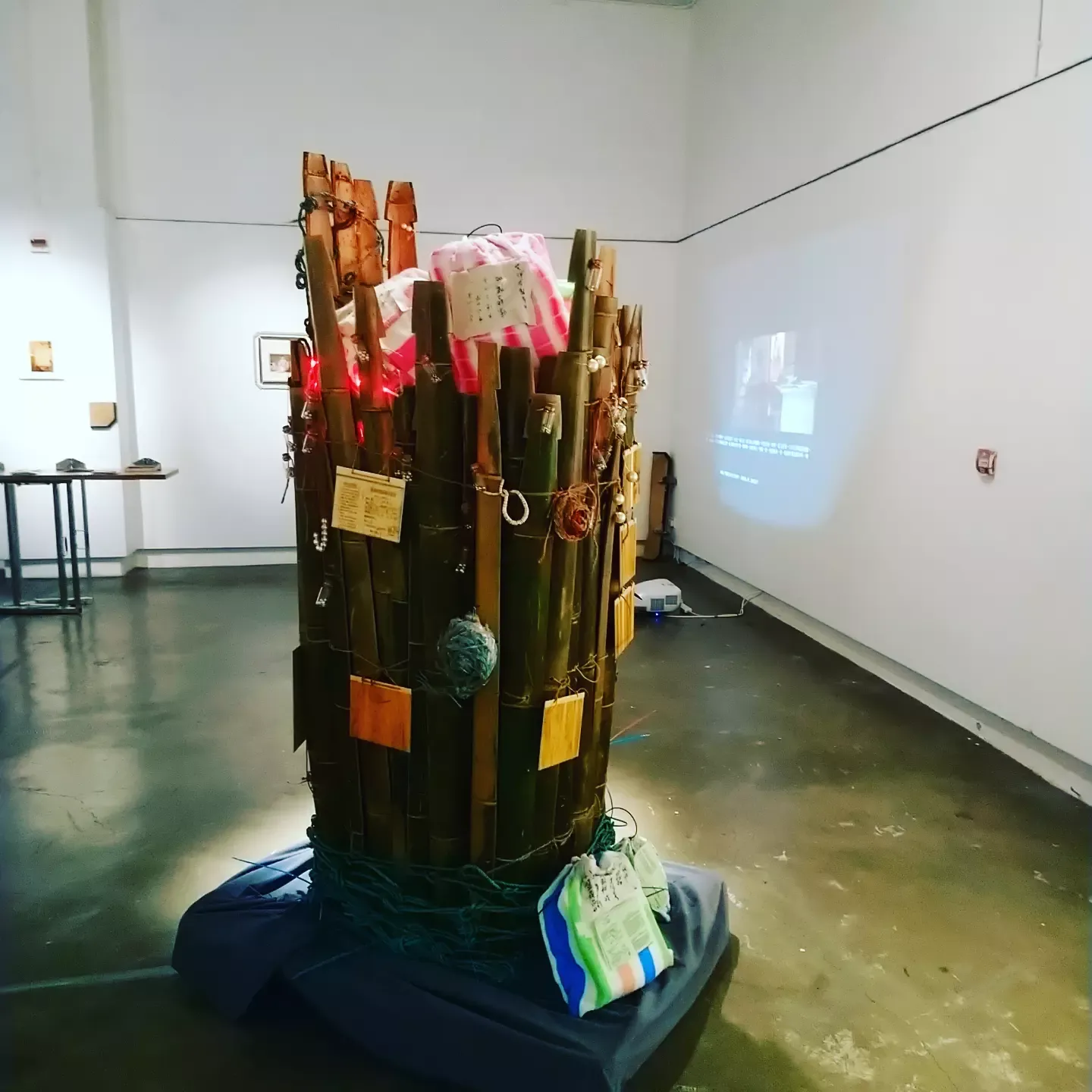[Mending Years 縫補歲月 group show, 2023.06.28-07.12 Gallery L0, JCCAC] Domestic Moonlighting (2023) is an adaptation of Lai's 1906-1989-2012: Guangzhou-Hongkong-Shanghai-Anji (2012), commissioned for the 9th Shanghai Biennale (2012-13), now permanently collected at Power Station, Shanghai. In her stipulation, domestic moonlighting by women and children in Hong Kong in the 1960s-80s amounted to postal volume of 57.5 million kg at the value of RMB94.7 million, sent from Hong Kong to China. 《家居副業》(2023)的前身為第9屆上海雙年展委約裝置《1906-1989-2012:廣州-香港-上海-安吉》(2012)。黎肖嫻的郵政考察顯示出上世紀六十到八十年代期間,香港婦女和小孩的家居副業從香港向中國支援,投遞了約五千七百五十萬公斤的小郵包物資,郵資總值九千四百七十萬人民幣。這只是小郵包的約數,未算進去的是一年一度用扁擔挑著回鄉的大包「心意」。
**revised 17 July 2023
**a full package on academia.edu: [… …]
1. Domestic Moonlighting: RMB94.7m for 57.5m kg | Linda Chiu-han Lai
家居副業的生產力:香港婦女,5750萬公斤,9470萬人民幣 | 黎肖嫻
HK Women’s domestic moonlighting around the 1960s-70s was a prominent economic contribution that has escaped official narratives of productivity. The assertion of the ubiquitous realities of female (and child) labor (outside the legal workplace) requires imaginative quantification and material visualization to compensate for the concrete labor that soft fictions of benevolence and perseverance (e.g. in melodramas) have failed to present.
“RMB94.7m for 57.5m kg” (1962 to 1989) is calculable postage volume that lures our imagination. My grandmother, my mother and myself happened to be contributors to these figures, through which we sustained stout connective tissues with another economy in their families in Guangzhou.
“Domestic moonlighting” is a term of contradiction. A housewife’s full-time job is to make sure the home is safe. In our family of five children, Mother regularly brought home handicraft jobs to make bracelets and necklaces with plastic beads and I was her extra pair of hands. Through 1960s-1970s. I would receive a dollar or two (HK currency) every time she got her wages. As for my Grandma, she did not share her “take-home assignment” with me: she spent her days rubbing hemp on the side of her lower right leg to make fine ropes used in traditional Chinese weighing scales, which left a patch of purple-colour skin as a permanent mark, which she probably did not want me to have.
The extra dollars earned afforded supplies to be sent back to Guangzhou, from uncooked peanuts, beans, dried crust (of bread), medicine, cooking oil to bottled fatty pork soaked in sugar. No photographs, no printed matters. And I was the little girl who regularly wrote letters on Grandma’s behalf to check little parcels from mother arrived properly for my uncle’s family, to ask why they were not writing, and to announce Grandma’s semi-annual visit, whereby larger-size supplies beyond postal provisions were carried on the two ends of a bamboo pole.
The small deeds of survival through domestic moonlighting were materialized through my research of statistics provided by the Postal Services. Tracking changes in the postal service protocols, I wanted to write an alternative economic history, in the spirit of Fernand Braudel’s micro-histories, highlighting micro economics, and Alf Luedtke’s “history of everyday life” beyond monumental regime accounts via writing miniatures of the quotidian landscape.
《家居副業》是從我、媽媽、外婆出發的另類經濟故事,用統計的理性,以官方的郵政總值去表述1962-1989「隱形」於家居而從未算進官方生產力的婦女勞動力。1981-82年,年終香港寄回大陸的小包裹從62/63年的1200萬件驟降至91萬件。數據背負的是大故事,可唯有個人的「小手作」才道出細活的血肉和質感。大陸廣闊的土地上無休止的變動在廣場上鐵路上重點城市裡上演,來到香港,主要場景化整為零,是低下階層擠迫的居所。家務時段之間的隙縫裡偷空的婦女和下課的孩子都凝神專注,把那些大袋小袋的「細藝」幹起來。我媽領來的不是最常聽見的待穿的塑膠花,而是頸鏈手鐲等,聽說都是送外國去的。換來的零錢,媽用來買合法過關的日常食物藥品,拿到郵政局寄出。外婆嘛,她扛來大把大束的乾草,在她右小腿外側推磨變出稱枰用的辮子繩,賺來的碎錢,用以換取一年兩度用扁擔挑回廣州的日用品,而我,就負責代她寫信預告行程。一直沒有被記帳的家居副業的生產力,慶幸香港郵政局的報告保留「實據」。我的裝置,揉合了事實、數據、背景資料,以至個人和集體記憶。

2. Background/Origin/Concept 背景、緣由、理念
This work is based on the artist’s work -- 1906-1989-2012: Guangzhou-Hongkong-Shanghai-Anji (mixed media installation, 7m (h) x 8m (d) x 6m (w)) -- commissioned for the 9th Shanghai Biennale (2012-13), now part of the permanent collection at the Power Station of Art, home for the SB. This original site-specific installation, a response to the reactivation of our urban past, plays with the reversal of what is backstage and frontstage in order to tell a HK (economic) story which has never been presented in this city – visible evidences of Cultural Revolution as it had been experienced and played out in Hong Kong’s quotidian landscape.
For the show “Mending Years,” 1906-1989-2012 is reworked into a set of sculptural objects specific for the venue to detail the domestic home and its connection to other social-cultural-economic histories. The work Domestic Moonlighting invites visitors’ recognition of the banal everyday objects as well as their curiosity to ask what role and value they once had in postwar Hong Kong society. Thus, this current iteration of the artist’s historiographic experiments commands detached scrutiny of a special ensemble of anthropological objects. “Domestic moonlighting” is a term of contradiction. Women’s full-time job, in this case my mother and grandmother's, was to make sure home was safe and the male breadwinner could go out to work: there were five children to feed, educate and to keep safe. My Mother, while sparing time to assist my goldsmith father, also brought home handy jobs like making imitation jewelry with plastic beads. The extra dollars earned allow father’s wages to focus on keeping the 8-person household going, so she could spend them on supporting needy folks in the Mainland. Mom spoke of fatty pork soaked in sugar in a glass bottle or iron container, to be sent back to Guangdong, sometimes uncooked peanuts were wrapped in parcel bags that cost more than the bag's content. Occasionally, medicine like Penicillin would be packaged to be sent as a registered post. I also recall, through remembering the letters I wrote, injection medicine for my uncle's liver problem.
Grandma's (semi-)annual trip back to the Mainland was a major event of the family. Time spent on accumulating the needed supplies aside, once or twice a year, our tiny flat will be crammed with gigantic bags as tall as half of my Grandma's height, which she would carry on her shoulders on the ends of a bamboo pole. Discussions on strategies to avoid trouble with the immigration officers at Shenzhen were some of the horror tales filling up my young days. Fear. Anxiety. Skilful packaging, careful speech when questioned. Ways to avoid unnecessary taxation. Safety. There was always the need to take advantage of a friend's travel plan so Grandma could tag along with some company. The story of domestic moonlighting, therefore, had a secondary stage, which is the journey from Tsimshatsui to Shenzhen and further, comprising of different spots for different potential dramas.
This is our HK-based family’s story of the Cultural Revolution. Detailing specific changes in postal service arrangements between Hong Kong and China, I am writing an alternative economic history, in the spirit of Fernand Braudel (Annales School of Historiography), based on my research on the changing costs of mailing daily necessities plus the many rules and restrictions. This history provides a counterpoint not only to the dominant narrative of economic progress/regress in HK/China, but that of the manufacturing boom in Hong Kong's success story.
By interweaving interpretive art objects, data, material objects, and open perceptual experience, Domestic Moonlighting asserts a space that at once highlights the vibrant presence of objects and resists reductive narrativization.

原作《1906-1989-2012∶ 廣州-香港-上海-安吉》為第9屆上海雙年展(上雙 2012-13)的策展人委託創作,環繞「為歷史重注活力」(reactivation) 的(策展主題)核心,在7米x 8米x 6米的空間裡玩弄舞台的前台和後台的倒置,擺放揉合了事實、數據、個人和集體記憶、背景資料的實地裝置,因果頓成懸疑,物件的感官性、聚散力自行說明了難以概括的敘事化的香港往事。
這個現為上雙在上海當代藝術館的永久收藏的作品重未在香港與觀眾見面,在「縫補歲月」群展裡,依循呈現香港經驗出發的文革故事的原意,重點卻轉移到香港勞工階層家居的場景,以小見大,把家居婦女的手作活動連接到香港戰後的民生經濟史的繁複脈絡。六零年代的火紅大陸燃點了香港低下層家居的燈火與灼熱,都是斗室裡的手作勞動力,指頭、關節、肌膚...。這次重新調動,以現成物組合出來的的雕塑群,強調數據和看似木訥的靜物,有藝術地組織過的,也有原材料的擺放,都以人類學的冷靜盤踞在展場一個角落。
《家居副業》是從我、媽媽、外婆出發的文革經驗。我是香港的土產;媽媽五零年代隻身來到香港為了按安排嫁給我的爸爸;而外婆是六零年代初來港跟我們一起住的。這個在廣闊的大陸土地發生的大故事,來到香港,主要場景化整為零,是低下階層擠迫的居所;尤其是日間,一家之主在外賺錢養活一家大小之際,家務時段與時段的隙縫裡偷空的婦女和下課的孩子,都凝神專注,把那些一袋又一袋的「活」細心的「幹」起來,好等改天媽媽盡快送走,再領回更多要幹的「細藝」,換來的零錢,可換合法過關的日常食物用品,送到郵政局寄出。是那些細藝呢?那就因家庭喜好或關係脈絡而異了。我知道同學們的家有不少是「穿膠花」的,我倒重未接觸過,朦朧中媽媽像是解釋過我也記不起來了。媽領來的袋,裏面都是形狀顏色圖案大小不一的膠珠,有時是各種形狀的膠片;我們家幹的是便宜的假首飾吧,送回去換錢的是一串一串的項鍊呀手鍊呀等等,聽說都是送外國的。翻閱香港郵政局出版的數據,5750萬公斤總值9470萬人民幣的郵包,就是香港婦女1960-80年代的家居副業的生產力,一直沒有被入檔、記帳,因而一直消失於正規的經濟發展的大故事。
3. Stringing plastic beads, a form of domestic moonlighting. New plastics. Pocket money. Postal subsidies. Daily necessities. 家居副業的一種:串珠仔 = 零用錢 = 郵遞補貼 = 送回大陸的家居日常禮品
It was an irony that my father was a crafty goldsmith whereas Mother and I devoted our time to make imitation jewelries. In the following are some found quotes on the big stories of beads-stringing practices in a quick search 有關「串珠仔」的大故事(Chinese translation by Linda Lai):
Source: https://vintagedancer.com/1960s/1960s-jewelry-styles-and-trends-to-wear/
“In the 1960s, other than the trend of vintage jewelry styles and Op Art and Pop Art influence, affordable low-cost plastics became in greater demand.”
上世紀六十年代,除了優質首飾以至歐普和普普風格外,便宜、負擔得起的塑膠產品需求日增。
“Resin, vinyl and Perspex could be produced on a mass scale, and at a very low cost. Paper, PVC , Lucite, and leather were other cheap materials. They allowed new ‘pop’ colors to shine: rich pink, turquoise, orange, and yellow. Jewelry designers seized the opportunity to produce designs in these new affordable materials.”
樹脂、乙烯基塑料和有機玻璃已經可以低成本的大量生產,紙、皮等物料亦相當便宜,因此普及的顏色可以發亮,帶粉紅、綠松石、帶橙、帶黃都可以。一時間,首飾設計師都爭取機會去設計和生產價錢大眾化的塑料飾品。
“Early plastics such as Bakelite and Catalin were developed at the beginning of the century. By the 1960s, advancements in technology produced new plastics. Designer Kenneth Jay Lane made his statement with oversized plastic jewelry encrusted with rhinestones. Elizabeth Taylor and Audrey Hepburn were often seen wearing his jewelry.”
塑膠的應用,早在二十世紀初已冒現。到一九六零年代科技進步,出現了嶄新的塑膠品種。設計師 Kenneth Jay Lane 以其超大的鑲嵌著水鑽的首飾作其個人宣言,其作品常由伊莉莎白泰萊和柯德莉夏萍兩位女星展示。

Making plastic jewelry was a common scene in the 1960s in domestic home-based workshop. Now, we have Yu Chau Street, nicknamed “the little bead street,” in Sham Shui Po (DIY suppliers) to preserve for us the token survival of the disappearing craft and the material base for contemporary imagination. What shouldn't be forgotten is that strung beads into fashionable fake jewelry has been an element of Hong Kong's flourishing export manufacturing activities – mainly to the US and the UK. But the actual volume remains obscure and cannot be further quantified.
昨天在家中廳房內的「穿珠仔」細藝是家居工作坊的特色風景,今天只能在「珠仔街」 -- 深水埗汝州街 – 找到可以延續我們想像的實據。「穿珠仔」是個微細的手作活動,牽連著的卻是香港出口英美的流行塑膠首飾業;要量化確實困難,隱藏在塑膠製品的整體出口數據中,只能由我們去想像。

It occurs to me that the facts of plastic jewelry are most likely embedded in the official statistics on export of plastic products, which, according to 1964 figures, was the second largest category of export, next to garment.
塑料首飾是六十年代香港本地製造業成品出口的一部份。上圖表的第三段 線型圖 -– 以塑膠產品為主的雜類 –- 排行總值的第二位,僅次於成衣類。
4. Sculptural Installation Domestic Moonlighting: RMB94.7m for 57.5m kg (2023): components
實物雕塑裝置《家居副業的生產力:香港婦女,5750萬公斤,9470萬人民幣》 (2023) 的構成部分
In the current iteration of my experimental-material historical accouont, the emphasis shifts away from HK-Mainland familial attachments to domestic moonlighting activities and Hong Kong’s postal history.
The sculptural ensemble has the following components:
(A) Bamboo totem: a tubular sculpture (~1.8m tall, 1m diameter) made with bamboo slabs bound by various kinds of ropes, with plastic beads and objects attached on the totem, standing upright, with postal packages in the core. The top of the totem-sculpture is infused with blinking red lights. The bamboo (anti-)monument is sound-interactive (mainly sounds of a train leaving a station), giving hints to the other sculptural components. It is in the centre of the space assigned to the work to facilitate visitors to walk around it.

(B) Statistical visualization deploying the Chinese scale as visual metaphor, hanged on the wall.

(C) Handmade mini sculpture: a pile of postage bags (typical parcels sent) of varied sizes made with color-striped towers lying in the corner of the exhibition space and inside the totemic bamboo sculpture.

(D) laser print images of the HK-Shenzhen border crossing – the monumentalization of a difficult journey. Laser printing on aluminum returns to the fleeting, vanished journeys a quality of permanence. 有關港深過關過境的過程,以雷射打印於鋁片上,作爲立碑式的紀念回顧。

(E) A zine – in the form of a big physical folder book – to be read on site: a reconstructed letter I wrote on behalf of my grandmother as a kid; “My Guangzhou in 10 Keywords”; documentation images of the work’s last iteration at the Shanghai Biennale; statistical table of postal spending (based on HK government figures, 1961-1989). The zine is placed on a table with loose parcel sculptures underneath.









